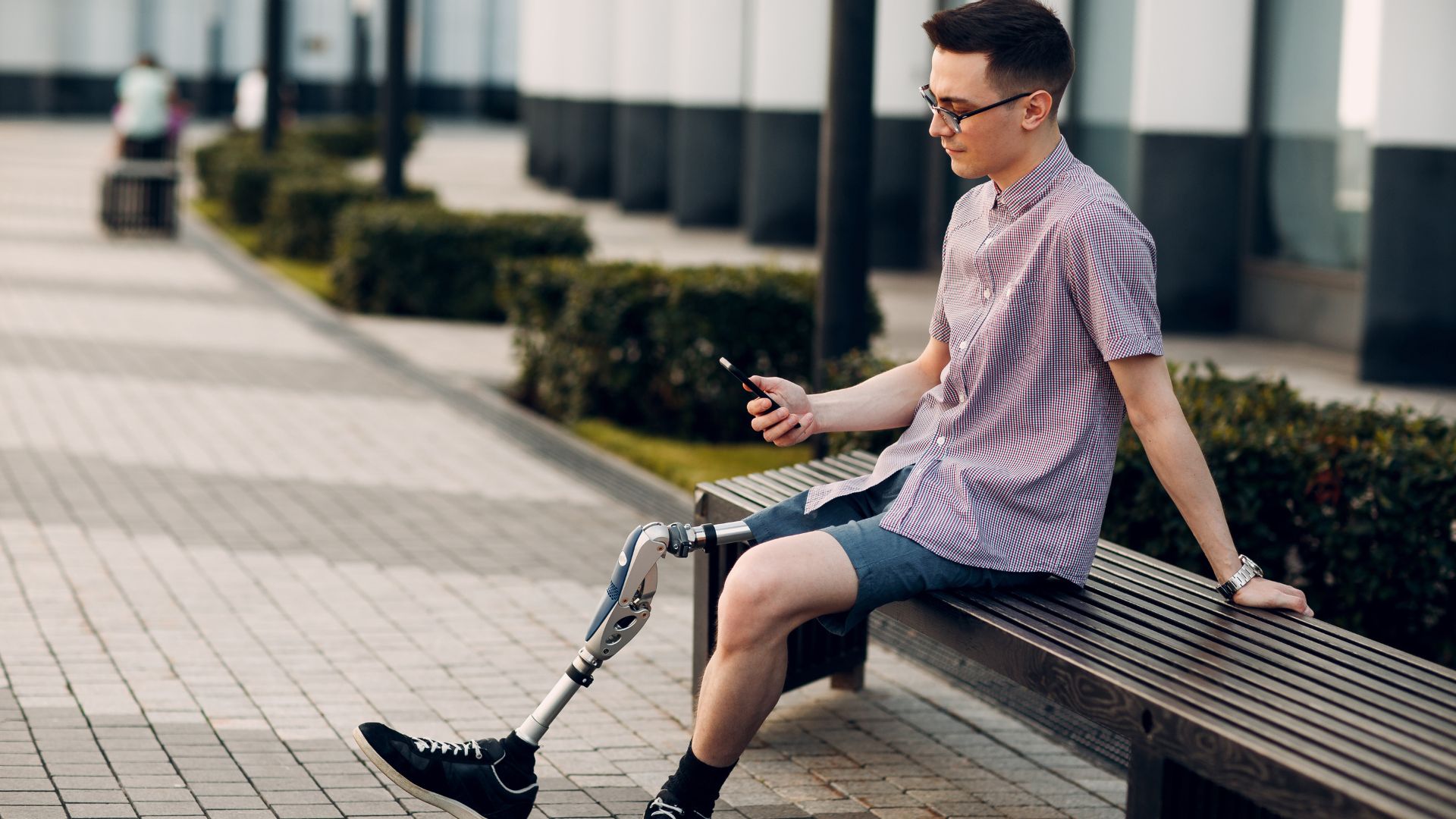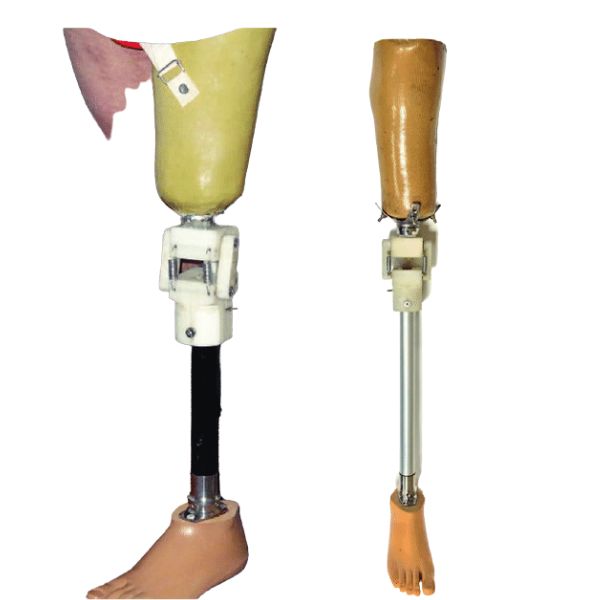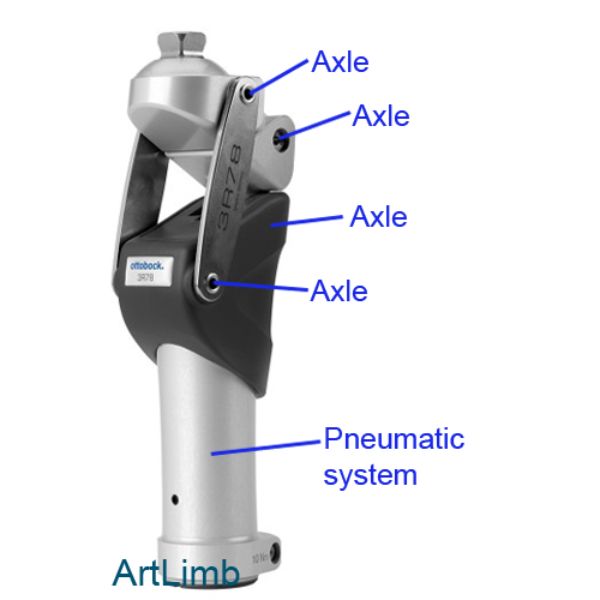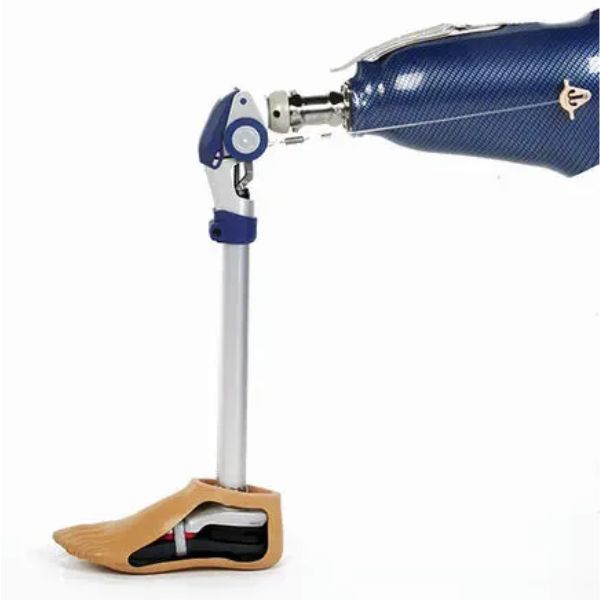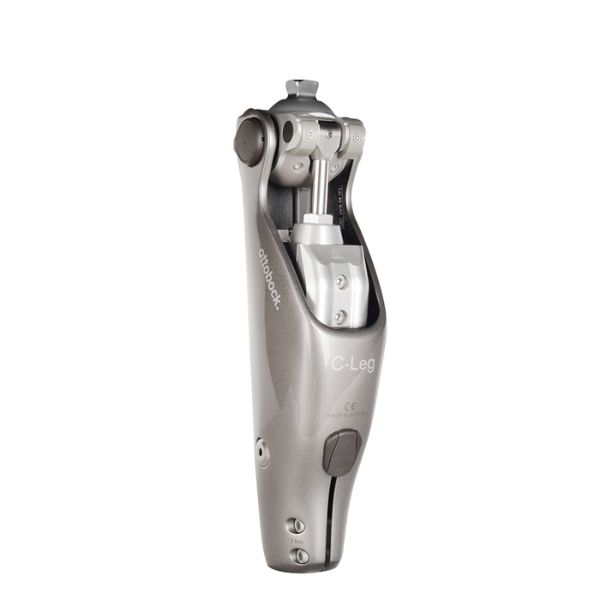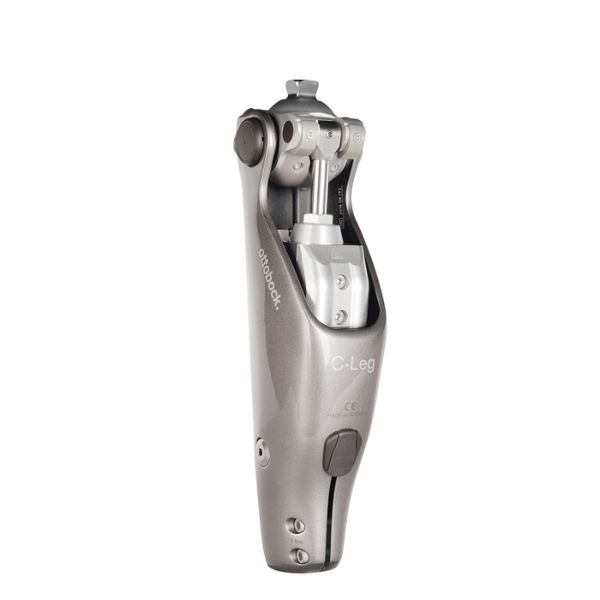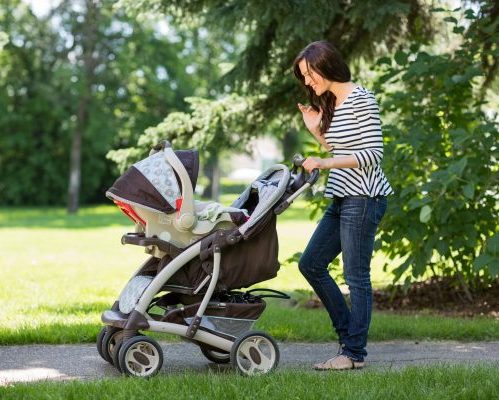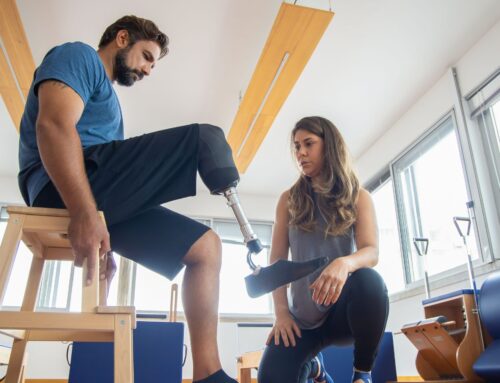There are many prosthetic leg options to choose from, and the best fit will be dictated by an individual’s level of injury, physical factors, complications, as well as their lifestyle and vocational or recreational goals.
Every amputation is different, and it is critical that persons who have sustained an amputation work with a certified prosthetist and physiotherapist to determine which kind of prosthesis will be the best option for them.
In this article, we will highlight prosthetic leg options and physiotherapy for through-knee or above knee amputation.
Table of Contents:
- What is a prosthetic leg?
- Common causes and complications of amputations
- Types of knee prostheses
- Mechanical knees
- Single axis knees
- Polycentric knees
- Manual locking knees
- Weight activated stance control knees
- Pneumatic or Hydraulic Knees
- Computerized knees
- Physiotherapy after leg amputation
- Conclusion
What is a Prosthetic Leg?
Prosthetic legs allow an individual who has sustained an amputation to walk with a more normal and energy efficient gait pattern and will often allow them to walk without the need for assistive devices such as crutches or walkers. In addition to enabling a more normal gait pattern, they allow the user to accommodate for sitting/standing, stairs/ramps as well as uneven terrain and different walking speeds.
A prosthetic leg includes several components including the socket, which is molded to the individual’s residual limb, the suspension system, which is how the prosthesis stays attached to the individual, and the prosthetic leg itself, which includes different options for knee and ankle joints.
Individuals can be fitted for a prosthesis once the wound from the amputation is stable and well-healed, which can be within a few weeks after the surgery. This may be delayed if they have complications related to the amputation.
After an above-knee or through-knee amputation, the residual limb shrinks, as the individual loses muscle mass in their thigh. Users will need to be fitted for multiple sockets over time to accommodate for the decreasing size of their residual limb.
Common Causes and Complications of Amputations
Amputation refers to the removal of a limb due to injury, disease, or surgery. It can be utilized as a surgical procedure to manage discomfort or a disease condition in the affected limb. Individuals can also undergo traumatic amputations resulting from motor vehicle accidents or workplace accidents.
There are several complications related to amputation such as infection, phantom limb pain (residual limb pain), slow wound healing, vascular issues and necrosis, neuromas, edema, and skin breakdown. Phantom pain is a common occurrence after an amputation and is perceived in the limb that has been removed from the body. It is typically characterized as a sharp or burning pain that occurs due to a miscommunication of nerve signals from the brain to the spinal cord.
Types of Knee Prostheses
Prosthetic knees allow a person who has sustained an amputation at or above the knee to regain use of the knee and ankle joints and participate more easily in their daily activities.
Prosthetic knees are divided into two categories, mechanical or computerized. Mechanical knees are further divided into single-axis, multi-axis, and polycentric knees. Each prosthesis has its own unique features which are chosen based on the user’s requirements.
Mechanical Knees
Single-Axis Knees Mechanism and Indications
This is the simplest type of prosthetic knee joint that allows for rotation around a single axis during flexion and extension of the knee. Individuals who use this type of knee require good muscle strength, as this type of prosthesis can be difficult to control. These are sometimes recommended when there are limited economic resources, as it is the most cost-effective option.
Advantages:
- This is a very simplistic design, durable, as well as light weight, which can be helpful for new amputees, who are just learning to walk.
- Most cost effective
Disadvantages:
- Due to this simplistic design, the user has to generate significant muscle power to keep the knee stable while standing and walking.
- Creates an unnatural gait pattern due to the simplicity of the single-axis design
- Can be difficult to control the locking and unlocking during gait, putting the user at higher risk for falls and injuries.
Polycentric Knees Mechanism and Indications
Unlike a single-axis knee, a polycentric knee allows multiple points of rotation around several axes. Polycentric joints can have either 4 or 7 bars, meaning that you can either have 4 points of rotation or 7 points of rotation. This type of joint provides good stability when there is involuntary flexion during the heel strike phase of walking because the center of rotation is located more proximally and posterior when the knee is fully extended. This knee is typically recommended for active people, or people who are more likely to walk independently, without a gait aid.
Advantages:
- Can be very stable in stance phase
- Allows the user to sit down with a bent knee
- Due to the multiple axes and the center of rotation, the prosthetic length “shortens” at the start of the swing phase of walking to allow for foot clearance
- Lighter than computerized knees
- Less expensive than computerized knees
Disadvantages:
- Much heavier than a single-axis joint prosthesis
- Greater energy requirement of muscles during walking to maintain gait efficiency and balance.
Manual Locking Knees Mechanism and Indications
This type of joint locks while the user is weight-bearing on it. They will need to manually disengage the lock to be able to sit down.
Advantages:
- Very stable
- Allows for an automatic lock in weight-bearing, with the additional option to manually lock the knee. This is especially important for people with less muscle control and balance, or who need more security while walking on uneven terrain.
Disadvantages:
- The user will need to swing the leg out or hike the hip to allow for adequate foot clearance during gait. This is an unnatural gait pattern, which can lead to further issues in the future in surrounding muscles and joints.
- Need to manually unlock the knee to sit with a bent knee
Weight Activated Stance Control (Safety) Knees Mechanism and Indications
This knee provides a constant friction force while weight is on the limb. This helps to prevent it from buckling when standing on that leg, while still allowing it to swing freely when unweighted.
Advantages:
- This is a very stable knee that is commonly prescribed when individuals first start using a prosthesis, and in older individuals and the less active community.
- This is also for people who can exert some control over their knee, but who fatigue quickly after a few steps, or people who forget that they cannot put weight onto a bent knee while using their prosthesis.
Disadvantages:
- With this prosthesis you are unable to get into a sitting position without taking all your weight off the leg.
- The individual has to take all of the weight off their affected side to allow it to swing resulting in a less efficient gait pattern
- Due to the constant friction in the knee, the individual will walk slower, with smaller steps.
Pneumatic or Hydraulic Knees Mechanism and Indications
Pneumatic/hydraulic components (pistons with cylinders containing air or fluid) can be added to either single-axis or polycentric mechanical knees, as well as computerized knees. This is to help increase mobility and control with the leg and allow the user to vary speeds. When walking faster it will limit the air flow and fluid to reduce the flexion of the knee to allow a faster walking pace. The opposite will happen with a slower gait. Typically, hydraulic knees work well for more active individuals.
Advantages:
- Allows the individual to walk more comfortably and with a more natural gait pattern.
- This type of knee also allows the individual to walk up and down the stairs with a reciprocal gait pattern, due to the resistance provided during flexion while there is weight on the leg.
- This is both less expensive and lighter than computerized knees.
Disadvantages:
- Hydraulic knees are often more expensive and heavier than pneumatic knees, they also need more maintenance.
- Cost is higher than mechanical knees.
Computerized Knees
Mechanism and Indications
These knees have microprocessors to allow feedback from within the knee or foot joint. Information from the sensors adjusts the range and speed of knee flexion and extension, according to the user’s requirements. Knee extension is powered, and resistance is provided through knee flexion, allowing the individual to more easily get in and out of a sitting position, and navigate stairs using a reciprocal gait pattern. It also allows for a symmetrical weight distribution and a natural gait pattern.
Advantages:
- These are much more advanced, which allows the gait to be more natural as well as allowing the leg to adjust to different speeds. Some offer stumble control, which will automatically put the leg into a position to prevent you from falling. This type of prosthesis allows the user to adjust to changes in speed, environment changes and specific situations. These also have different programmable modes for when you are doing different activities (i.e. cycling)
- More efficient gait pattern with less energy expenditure during gait
- Allows the user to navigate stairs using a reciprocal gait pattern
Disadvantages:
- These are very expensive and need to be charged regularly.
- Heavier than the other options and can also be damaged by different environmental conditions.
- Can be more difficult to cover or wear certain types of clothing overtop
- Learning curve when first starting to use this type of device
- Regular maintenance required
Physiotherapy After Leg Amputation
The nature of rehabilitation after a leg amputation at or above the knee will depend on the client’s goals and physical presentation but will often include:
- Gait assessment and prosthesis training
- Gait aid training
- Transfer training
- Static and dynamic balance training
- Strengthening the hip muscles of the residual limb, as well the muscles of the sound leg, and core.
- Desensitization techniques / mirror box therapy
- Manual therapy – to normalize muscle tension and joint mobility
- Edema management
- Education on activity modification and return to recreational activities
- Collaboration with the prosthetist on adjustments to the prosthesis
Conclusions
When an individual has undergone an amputation at or above the knee, learning to use a prosthetic leg is often a crucial step in the rehabilitation process. A well-fitting prosthesis can help individuals regain mobility and return to their daily activities. This allows the freedom and independence to get back to doing the activities that are important to them.
The physiotherapists at Propel Physiotherapy are trained in the rehabilitation of individuals who have sustained an amputation. They will work with you to explore your individual needs and rehabilitation goals and create an individualized treatment plan. If you have any questions about rehabilitation after an amputation, please reach out to us at info@propelphysiotherapy.com or 416-621-2506 to schedule a complimentary consultation with one of our clinicians.
Written by

